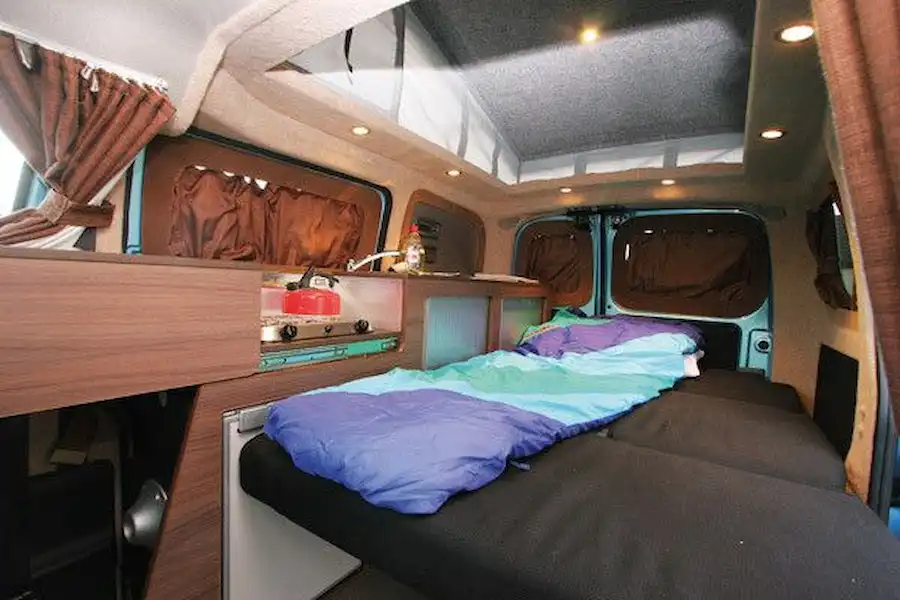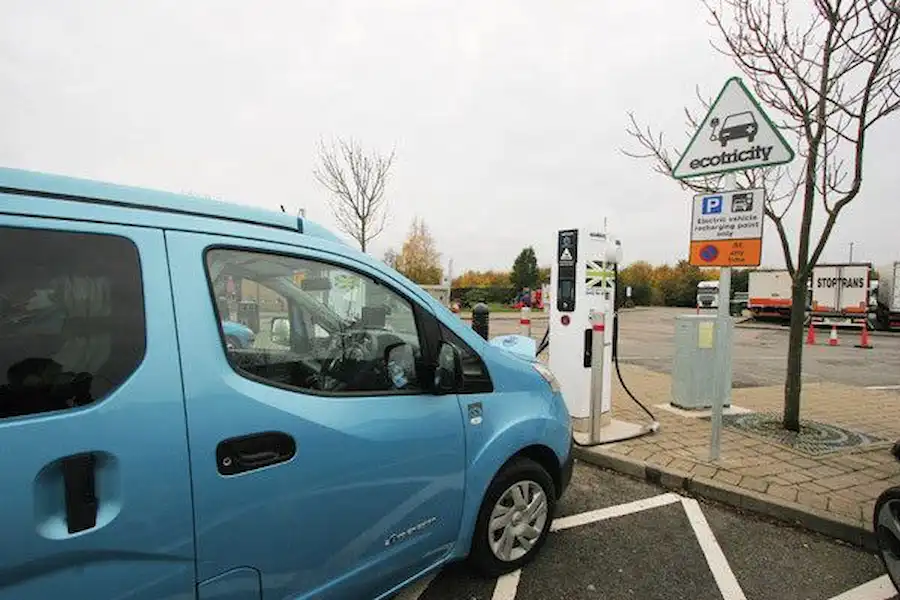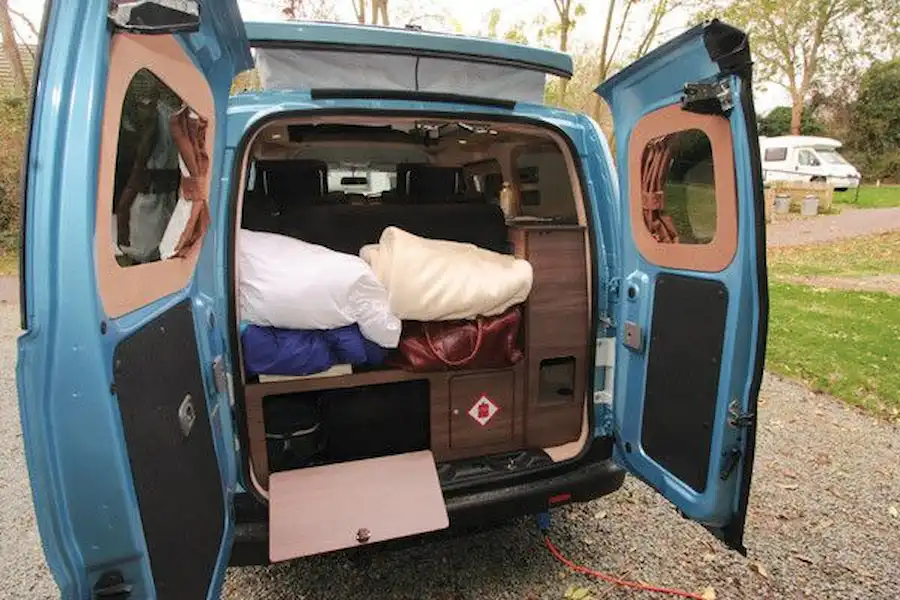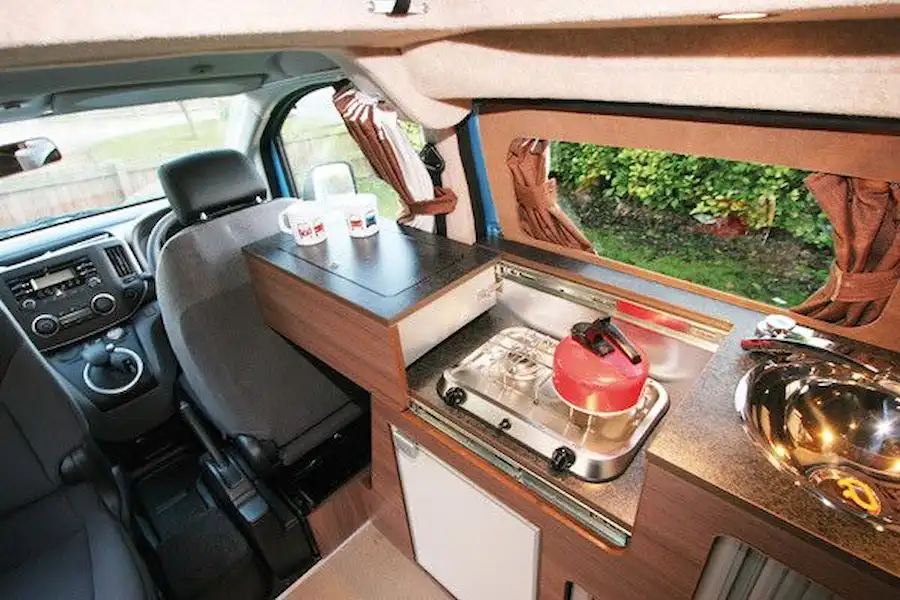Key Features
| Model Year | 2015 |
| Class | Rising Roof |
| Base Vehicle | Nissan e-NV200 |
| Price From (£) | 29,995 |
| Length (m) | 4.56 |
| Berths | 2 |
| Belted Seats | 4 |
| Main Layout | Campervan |
At a glance
Full review
In 2013, UK sales of electric cars may have almost doubled compared with the previous year, but that was to a total of just over 2,500 – out of 2.26 million registrations!
There are good reasons to consider an electric vehicle, though, not least the current government grant towards the purchase of a brand new one – saving you up to £8,000. Then there’s the zero Benefit in Kind taxation if it is a company car, the exemption from London’s Congestion Charge and the free road tax. Add in running costs claimed to be as low as 2p per mile for the Nissan e-NV200 and servicing prices 40% lower than for a petrol or diesel van and you might fancy reading on. We certainly wanted to find out more.
Of course, Hillside already converts the diesel-engined NV200 so it was able to carry over the Dalbury conversion virtually unchanged to the electric e-NV200. The 360V laminated lithium-ion battery that propels the vehicle lives under the floor, so the internal space available for the Dalbury conversion is exactly the same as in the conventional version.
The electric van does look a little different externally, however, with a nose like the Leaf electric car – or a Moomin cartoon character, according to my wife. The e-NV200 also comes in three trim levels and with or without fast charging. Care needs to be exercised when specifying a van for conversion; using the cab heater reduces range but the optional heated seat and steering wheel do not as they draw current from the lead acid battery under the bonnet (which also powers lights and wipers). And Nissan’s Carwings sat-nav goes from being a luxury to almost a necessity as it tells you how much charge you need to reach your destination, pinpoints charging stations on your route and links to your smartphone to allow you to activate charging remotely or switch on the air-con.
Press the start button and the dashboard lights up but you feel a bit daft waiting for something else (noisy) to happen. Of course, nothing else does happen. Put your foot on the brake, select drive with the automatic shifter, release the handbrake and you’re off… silently.
The combination of the quietness and the instant acceleration is a real surprise if you haven’t already converted to electric motoring. Forget analogies of milk float performance, the Nissan will go from 0-62mph in 14 seconds and then on to a claimed 76mph maximum. And its 254Nm of torque (that’s slightly more than a 114PS 2.0TDI Bluemotion VW T5) is available from rest, so it feels even livelier.
If the motivation of the Dalbury E is revolutionary, then the motorhome aspects are quite ordinary. There’s no wind-powered cooker, levitating bed or carbon-fibre kitchen. But it’s probably all the better for playing it safe.
The layout is the evergreen ‘VW camper’ floorplan, just downscaled to fit in a smaller vehicle. The two-burner hob from Smev, compressor fridge from Vitrifrigo and rear seat/bed from RIB are all familiar enough, too. But there are clever details, especially the way the hob is hidden and then appears when the little cupboard above it slides into the cab. An idea borne out of necessity (to ensure sufficient headroom atop the cooker to meet industry standards), this design actually creates extra worktop and a useful home for all your cutlery and crockery.
With 100,000 Nissan electric vehicles already on the world’s roads and a five-year warranty on the battery, there should be no worries about unproven technology and, as the affable warden at Cherry Hinton points out, there are plenty of people who camp within an hour’s drive of home. Clearly, battery technology has a way to go before it will replace diesel for us all, but if this Hillside is an indication of the future then motorhoming can only get better.
This is an abridged version of the full review which appears in the January issue of Which Motorhome.
Expert motorhome advice to your door!
Why not subscribe to one of our fabulous magazines and get expert advice, travel ideas, technical help and all the latest news for your motorhome and your motorhome adventures!
Want to know more about MMM magazine?
Every month MMM has articles written by motorhomers who have been there and done it, from great UK and European (and further afield) tours, campsite reviews, owners' reports and DIY projects among other things. MMM's tests, reviews and expert buying guides are not to be missed. MMM's technical advice is a must and includes everything from weekend jobs to longer-term DIY projects. And much more!
About MMM magazineWant to know more about What Motorhome magazine?
Every issue of What Motorhome magazine provides essential buying advice for anyone looking to buy a new motorhome or campervan or upgrade their existing model. With a pedigree of over 30 years of offering the best motorhome and campervan buying advice, every issue of What Motorhome includes more new motorhome and campervan reviews than you will find in any other magazine.
About What MotorhomeWant to know more about Campervan magazine?
Campervan is the exciting monthly magazine that will give you all the inspiration you need to explore the world in your campervan. Every issue is packed with real-life campervanning experiences, inspiring travel ideas in the UK and further afield, the best campsites to stay on, campervan road tests and reviews of the latest models, and much more!
About Campervan magazine


















